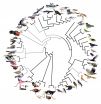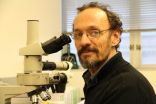(Press-News.org) Highlights
In patients on dialysis, cinacalcet reduced the rate of bone fracture by 16% to 29%, after accounting for patient characteristics and other factors.
Washington, DC (December 11, 2014) -- A drug that mimics calcium and lowers parathyroid levels may help prevent bone fractures in patients with kidney failure who are on dialysis, according to a study appearing in an upcoming issue of the Journal of the American Society of Nephrology (JASN).
Patients with kidney failure who are undergoing dialysis have an increased risk of bone fractures, and the risk of dying after a hip fracture in such a patient is double that of the general population. Unfortunately, none of the approved drugs for fracture prevention in osteoporosis in the general population are approved for use in patients on dialysis, and some are actually contraindicated.
Sharon Moe, MD (Indiana University School of Medicine and Roudebush Veterans Administration Medical Center) and her colleagues conducted a study to see whether cinacalet, a drug that lowers parathyroid hormone (PTH), can reduce the risk of fractures in patients receiving dialysis. These patients have elevated PTH levels due to problems with the way the body handles calcium when the kidneys are dysfunctional. In animals, lowering the level of PTH improves bone structure and reduces fractures.
The investigators conducted a planned secondary analysis of the EVOLVE trial, the largest study in hemodialysis patients to date. This study compared cinacalcet vs. placebo, on a background of standard of care. Clinical fractures were observed in 255 of 1935 (13.2%) patients randomized to placebo and 238 of 1948 (12.2%) patients randomized to cinacalcet. While cinacalcet did not reduce the rate of clinical fractures in unadjusted analyses, it had a protective effect against fractures after the researchers accounted for differences in patient characteristics and events that prompted patients to discontinue treatment.
"Our results showed a reduction in fracture risk by 16% to 29% in the patients receiving cinacalcet when adjusted for other fracture risk factors like age," said Dr. Moe.
INFORMATION:
Study co-authors include Safa Abdalla, Glenn M. Chertow, Patrick S. Parfrey, Geoffrey A.
Block, Ricardo Correa-Rotter, Jürgen Floege, Charles A. Herzog, Gerard M. London,
Kenneth W. Mahaffey, David C. Wheeler, Bastian Dehmel, William G. Goodman, and
Tilman B. Drüeke, for the Evaluation of Cinacalcet HCl Therapy to Lower Cardiovascular
Events (EVOLVE) Trial Investigators.
Disclosures: The study was sponsored by Amgen, and several of the authors report financial disclosures in the form of grants or consulting fees from Amgen. Two authors are employed by Amgen.
The article, entitled "Effects of Cinacalcet on Fracture Events in Patients Receiving Hemodialysis: The EVOLVE Trial," will appear online at http://jasn.asnjournals.org/ on December 11, 2014.
The content of this article does not reflect the views or opinions of The American Society of Nephrology (ASN). Responsibility for the information and views expressed therein lies entirely with the author(s). ASN does not offer medical advice. All content in ASN publications is for informational purposes only, and is not intended to cover all possible uses, directions, precautions, drug interactions, or adverse effects. This content should not be used during a medical emergency or for the diagnosis or treatment of any medical condition. Please consult your doctor or other qualified health care provider if you have any questions about a medical condition, or before taking any drug, changing your diet or commencing or discontinuing any course of treatment. Do not ignore or delay obtaining professional medical advice because of information accessed through ASN. Call 911 or your doctor for all medical emergencies.
Founded in 1966, and with more than 15,000 members, the American Society of Nephrology (ASN) leads the fight against kidney disease by educating health professionals, sharing new knowledge, advancing research, and advocating the highest quality care for patients.
Stroke is Australia's second biggest killer after coronary heart disease, but rates of a common type of stroke, intracerebral haemorrhage (ICH), appear to be falling, according to a UNSW study that is the largest of its kind in Australia.
ICH accounts for about 15% of all strokes. Close to 40% of patients will die within 30 days and significant disability is common in survivors.
The improvement in the incidence of ICH may be the result of the widespread implementation of proven prevention and treatment programs, the researchers say.
The large retrospective, observational ...
The most ambitious genetic study ever undertaken on bird evolution has found that almost all modern birds diversified after the dinosaurs became extinct 66 million years ago.
"The popular view until now has been that the extraordinary diversity of birds began during the dinosaur age but we found little support for this," said Associate Professor Simon Ho, from the University of Sydney who led a major component of the research looking at evolutionary timescale.
An international collaboration of scientists worked for four years to sequence, assemble and compare the ...
People with a high level of education who complain about memory lapses have a higher risk for stroke, according to new research in the American Heart Association journal Stroke.
"Studies have shown how stroke causes memory complaints," said Arfan Ikram, M.D., associate professor of neuroepidemiology at Erasmus University Rotterdam in The Netherlands. "Given the shared underlying vascular pathology, we posed the reverse question: 'Do memory complaints indicate an increased risk of strokes?'"
As part of the Rotterdam Study (1990-93 and 2000-01), 9,152 participants 55 ...
Children with public insurance waited longer after initial evaluation for sleep-disordered breathing (SDB) to undergo polysomnography (PSG, the gold standard diagnostic test) and also waited longer after PSG to have surgery to treat the condition with adenotonsillectomy (AT) compared with children who were privately insured, according to a report published online by JAMA Otolaryngology-Head & Neck Surgery.
Low socioeconomic status (SES) is a barrier to quality care and improved health outcomes. SDB is a spectrum of sleep disruption that ranges from snoring to obstructive ...
EAST LANSING, Mich. - It's well known that chemotherapy helps fight cancer. It's also known that it wreaks havoc on normal, healthy cells.
Michigan State University scientists are closer to discovering a possible way to boost healthy cell production in cancer patients as they receive chemotherapy. By adding thymine - a natural building block found in DNA - into normal cells, they found it stimulated gene production and caused them to multiply.
The study can be found online in the journal Molecular Cell.
"In most cases, cancer patients who receive chemotherapy lose ...
MADISON, Wis. -- Frederick Crane was a researcher under David E. Green in the mid-1950s, during the early days of the University of Wisconsin-Madison Enzyme Institute, when he made his defining discovery.
The lab group was on a mission to determine, bit by bit, how mitochondria -- the power plants of cells -- generate the energy required to sustain life. What Crane found, a compound called coenzyme Q, was a missing piece of the puzzle and became a major part of the legacy of mitochondrial research at UW-Madison. But it was no accident.
"It was the result of a long ...
Montréal, December 11, 2014 - Researchers in Montréal led by Jacques Drouin, D.Sc., uncovered a mechanism regulating dopamine levels in the brain by working on a mouse model of late onset Parkinson's disease. The study, conducted in collaboration with Dr. Rory A. Fisher from the Department of Pharmacology at the University of Iowa Carver College of Medicine, is published online today by the scientific journal PLoS Genetics.
Using gene expression profiling, a method to measure the activity of thousands of genes, researchers investigated dopaminergic neurons in ...
WEST LAFAYETTE, Ind. - A new method that creates large-area patterns of three-dimensional nanoshapes from metal sheets represents a potential manufacturing system to inexpensively mass produce innovations such as "plasmonic metamaterials" for advanced technologies.
The metamaterials have engineered surfaces that contain features, patterns or elements on the scale of nanometers that enable unprecedented control of light and could bring innovations such as high-speed electronics, advanced sensors and solar cells.
The new method, called laser shock imprinting, creates shapes ...
A new study led by researchers at University of California, San Diego School of Medicine finds that the brains of obese children literally light up differently when tasting sugar.
Published online in International Journal of Obesity, the study does not show a causal relationship between sugar hypersensitivity and overeating but it does support the idea that the growing number of America's obese youth may have a heightened psychological reward response to food.
This elevated sense of "food reward" - which involves being motivated by food and deriving a good feeling ...
PORTLAND, Ore. -- A large international group of scientists, including an Oregon Health & Science University neuroscientist, is publishing this week the results of a first-ever look at the genome of dozens of common birds. The scientists' research tells the story of how modern birds evolved after the mass extinction that wiped out dinosaurs and almost everything else on Earth 66 million years ago, and gives new details on how birds came to have feathers, flight and song.
The consortium of more than 200 scientists is publishing its findings nearly simultaneously this week ...

